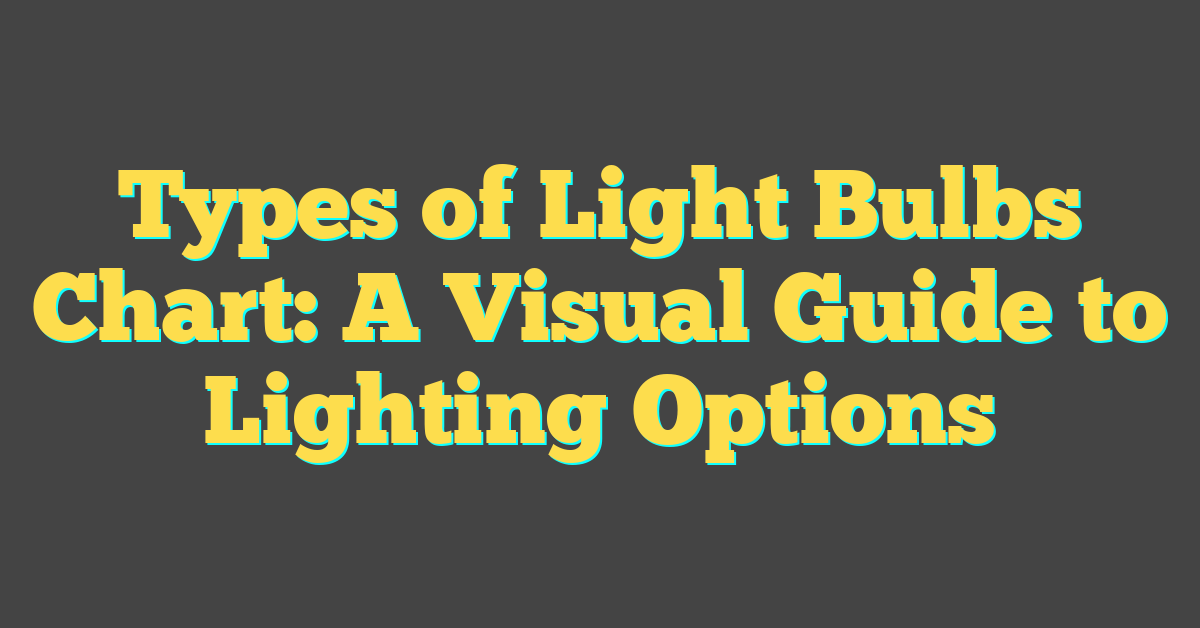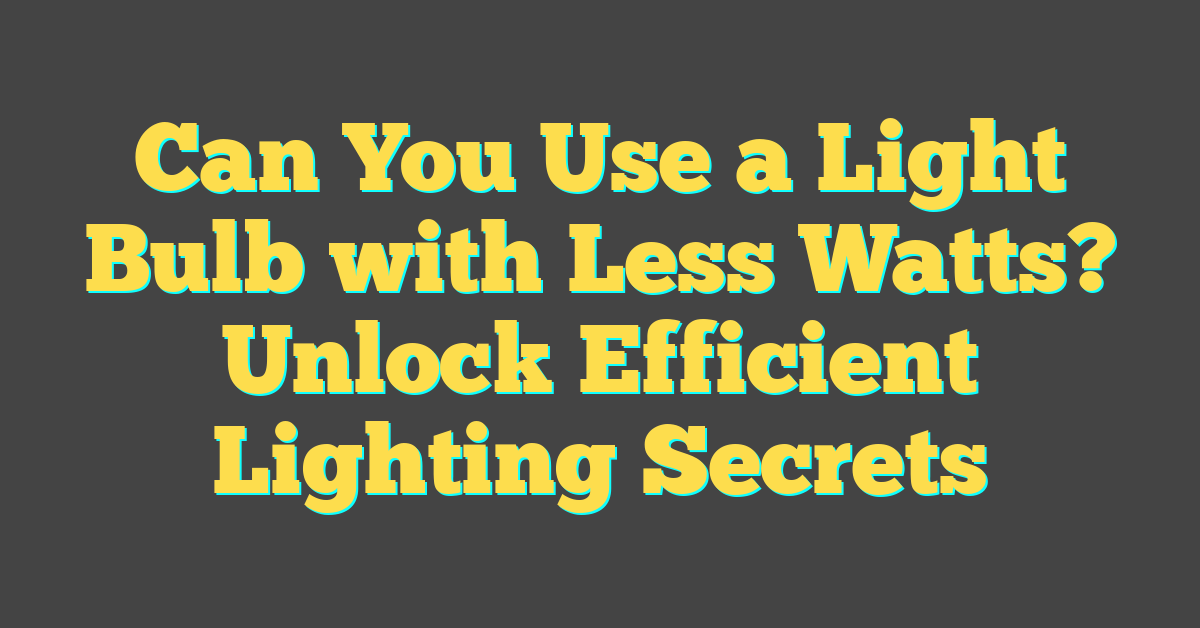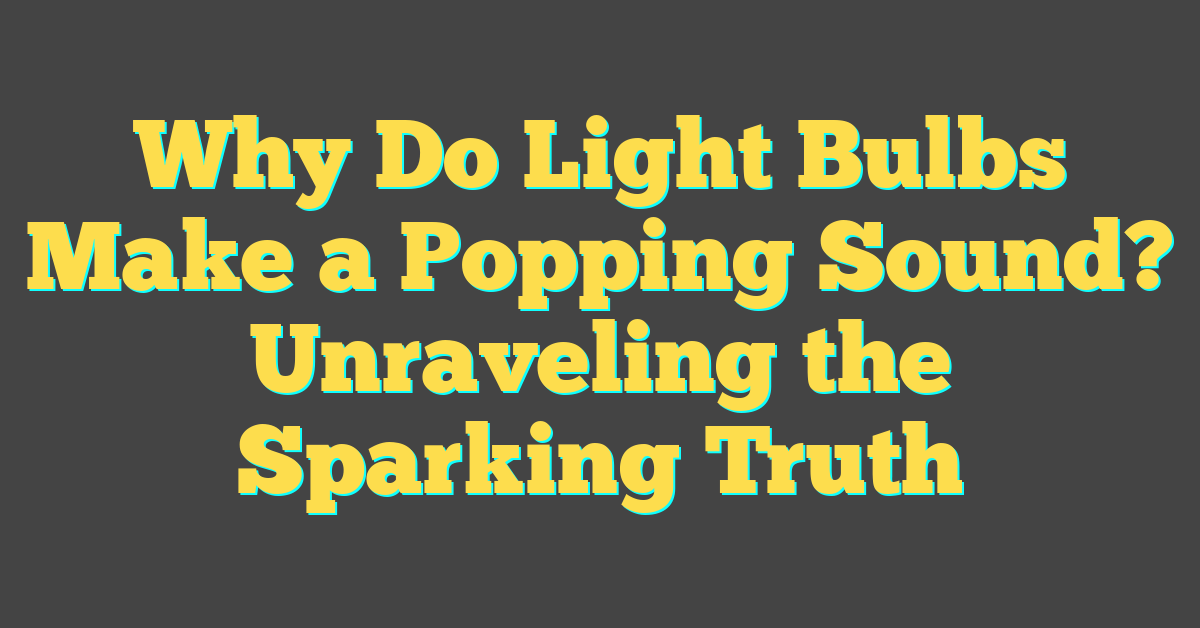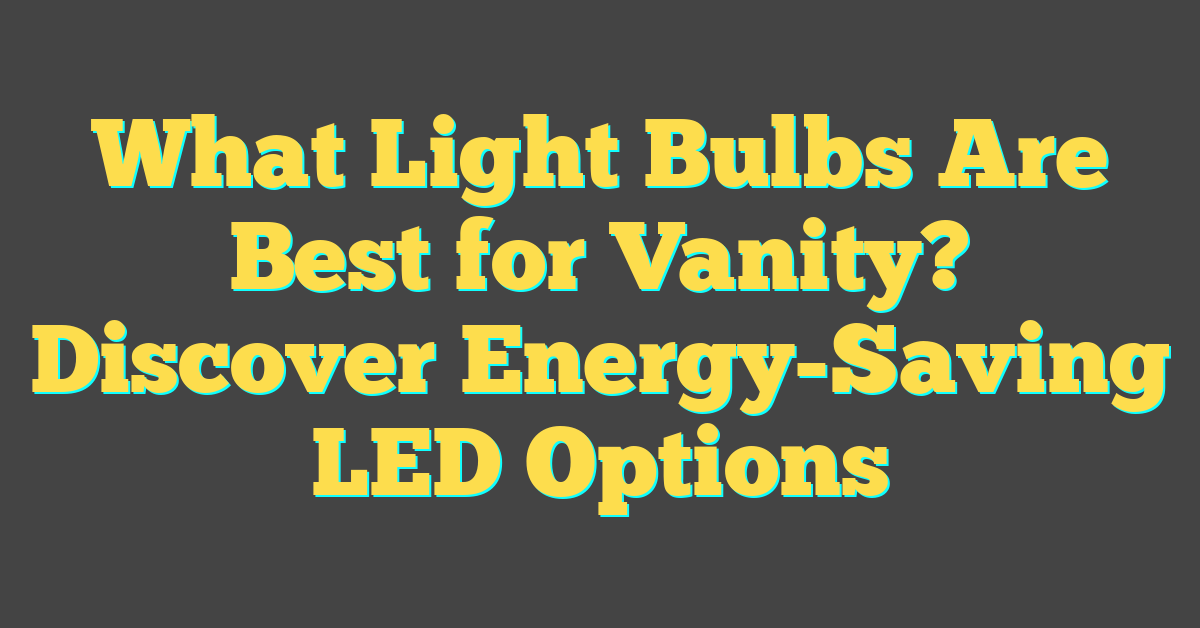Navigating the world of light bulbs can initially seem daunting with the variety of shapes, sizes, and types available. Understanding the differences between bulbs is essential in selecting the right one for your needs. From the warm glow of living room lamps to the bright light of office fixtures, the type of light bulb you choose has a significant impact on the ambiance and functionality of your space.


Innovation in lighting technology has transformed how we view and use light. LED, compact fluorescent (CFL), incandescent, and halogen bulbs each offer distinct advantages and nuances. The evolution of these light sources ranges from the traditional incandescent to the modern, energy-efficient LED. Whether it’s the shape like A19, the base type such as E26, or the color temperature, the specifications of your bulb are paramount in achieving desired lighting effects, energy savings, and mood setting.
Key Takeaways
- Light bulb specifications directly affect room ambiance and functionality.
- Advancements in lighting technology contribute to a diverse range of bulb options.
- Choosing the right bulb involves considerations of shape, type, and energy efficiency.
History and Evolution of Light Bulbs
https://www.youtube.com/watch?v=uszG5FD1_Uw&embed=true
The journey of light bulbs is quite an adventure! It all started with the Carbon Arc Lamp. This lamp, introduced by Sir Humphry Davy in the early 1800s, was the first electric light, a remarkable turning point in history. Then, in the 19th century, two inventors, Heinrich Geissler and Julius Plücker, made strides with the creation of the Geissler tube, which glowed when electric currents passed through it.
Incandescent bulbs took the stage when Thomas Edison and others perfected the design, offering longer-lasting and practical lighting for everyday use. This quickly became the standard and lit homes for many years. Advances led to the development of halogen bulbs, which are a type of incandescent but are more efficient and have a longer lifespan.
By the 1930s, another type of lighting was emerging: fluorescent bulbs. These tubes, filled with mercury vapor that emits UV light when electrified, were coated on the inside to convert UV to visible light, offering a different kind of illumination compared to the warm glow of incandescent bulbs.
The LED (Light Emitting Diode) has surged in popularity due to its incredible efficiency and lifespan. LEDs use a semiconductor to convert electricity into light, and since they’ve become more affordable, you’ve likely noticed these little guys popping up everywhere, from homes to electronic devices and even streetlights.
| Era | Bulb Type | Feature |
|---|---|---|
| 1800s | Arc Lamp | First electric light |
| 1800s | Geissler Tube | Early gas discharge tube |
| Late 1800s – early 1900s | Incandescent | Warm glow, widespread use |
| Mid 1900s | Halogen | More efficient incandescent |
| 1930s | Fluorescent | Energy-efficient, long tubes |
| 21st Century | LED | Highly efficient, long-lasting |
Remember, with every switch, you’re part of the ongoing evolution of lighting!
Understanding Light Bulb Types
https://www.youtube.com/watch?v=edBP810gJGY&embed=true
Navigating the world of light bulbs can be simpler than you think. Whether you’re brightening up your living space or setting the mood, understanding the different types of light bulbs will help you make the best choice for your needs.
Incandescent Bulbs
Incandescent bulbs are classic light sources that produce a warm glow. They work by running an electric current through a thin filament, heating it until it shines. These bulbs typically have a shorter life span and are less energy-efficient compared to more modern technologies.
Halogen Bulbs
A variant of incandescent bulbs, halogen bulbs provide a bright, white light and are more energy-efficient than traditional incandescents. They produce light by passing an electric current through a tungsten filament, which is enclosed in a small amount of halogen gas, extending the bulb’s life span.
Compact Fluorescent Lamps (CFLs)
CFL bulbs are easily identified by their spiral shape and offer a longer life and greater energy savings compared to incandescent and halogen bulbs. They emit light when the electric current drives a chemical reaction involving mercury and phosphor, resulting in visible light.
Light Emitting Diodes (LEDs)
LED bulbs represent the latest in lighting technology, known for their long life and energy efficiency. They illuminate by passing an electric current through a semiconductor material, which then emits light. LEDs are versatile, available in various colors and temperatures, and are excellent for both directional and diffuse lighting situations.
Light Bulb Shapes and Sizes
« Light Bulbs Good for Plants: Choosing the Right Illumination for Healthy Growth
DIY Light Bulb Fragrance Ring: A Simple Guide for Scented Ambience »
https://www.youtube.com/watch?v=M6gVOgG4n9I&embed=true
When you’re looking to replace or upgrade your light bulbs, knowing the various shapes and sizes available helps you make the best choice for your needs. Each shape has its unique characteristics and is suited for different purposes.
Standard Light Bulbs
A19 bulbs are likely what you think of when you imagine a standard light bulb. They have a classic pear-like shape and are commonly used in household lamps and overhead light fixtures. These bulbs fit well in a variety of settings, making them a versatile choice for your lighting needs.
Globe Bulbs
Globe bulbs, including the G25 or G40, are larger, spherical in shape, and typically used in vanity lighting or pendant light fixtures. Their round appearance provides an even, diffused light that’s perfect for areas where you need ambient lighting without harsh shadows.
Spotlight Bulbs
Spotlight bulbs, such as BR30 and BR40, have a reflective coating inside the bulb to direct light forward. These are ideal for recessed cans or track lighting where focused illumination is required. They are excellent for highlighting artwork or creating accent lighting in a room.
Tube Bulbs
Fluorescent tube bulbs, including the T12, are long cylindrical tubes often used in office spaces, garages, or basements. These bulbs provide a lot of light over a wide area and are energy-efficient, making them a practical choice for large spaces that need consistent lighting.
Light Bulb Base Types
https://www.youtube.com/watch?v=k9e37nJ3EBE&embed=true
When you’re replacing a bulb or choosing a new one, knowing your light bulb base types is essential. Typical bases include screw and pin types, each designed to fit into your fixture in a way that makes electrical contact safe and reliable.
Screw Bases:
- Miniature: Usually found in small, specialty lamps.
- Candelabra (E12): Often found in decorative lighting, chandelier, and night lights.
- Intermediate (E17): Larger than candelabra bases, fitting some ceiling fans and appliances.
- Medium (E26): The standard base for most household light bulbs.
- Mogul (E39): Used for high-wattage bulbs often seen in commercial settings.
Pin Bases:
- Fluorescent Pin Bases: Includes miniature, medium, and double contact bases. They are generally used for tubular fluorescent bulbs.
For specific bulb types like the A15, these bulbs usually have a medium E26 base but are smaller than the typical household bulb, suited for appliances and smaller lamps. The C7 base, on the other hand, is a miniature base commonly seen in night lights, Christmas lights, and some specialty lamps.
Here’s a quick reference to help you match common light bulb bases to their appropriate fittings:
| Bulb Type | Base Type | Common Usage |
|---|---|---|
| A15 | Medium E26 | Appliances, smaller fixtures |
| C7 | Miniature | Decorative, night lights |
By familiarizing yourself with these bases, you’ll find it much easier to identify the right bulb for your needs when you’re shopping or replacing an existing one. Remember that the base type is just as important as the bulb’s shape and size for ensuring a proper fit in your fixture.
Color Temperature and Lighting Mood
https://www.youtube.com/watch?v=rmN-xpor8Yk&embed=true
When you’re choosing light bulbs, understanding color temperature can greatly influence the mood and ambiance of a room. Measured in degrees Kelvin (K), color temperature describes how the light appears when you look at it.
Here’s a helpful breakdown to guide you:
- Warm Light: Ranging between 2000K and 3000K, these bulbs emit a cozy, calm glow that is perfect for relaxing. Think of the golden hue of a sunrise or the soft radiance of candlelight.
- Daylight: This is at the higher end of the spectrum, around 5000K to 6500K. Daylight bulbs are energetic and bright, mimicking noon sunlight. They’re excellent for areas where you need clear, sharp focus, like in a home office or a kitchen.
We can visualize the color temperature spectrum using a simple table:
| Kelvin (K) | Light Quality | Typical Use |
|---|---|---|
| Below 3000K | Warm, soft white | Bedrooms, living rooms |
| 3100K to 4500K | Bright white | Kitchens, bathrooms |
| Above 5000K | Daylight | Workspaces, reading areas |
Remember, the higher the Kelvin number, the cooler and bluer the light. Conversely, a lower Kelvin number will give you a warmer, more yellowish glow. Tailoring the right kelvin setting for your space not only affects how you see but also how you feel, whether you’re unwinding after a long day or concentrating on a task.
Energy Efficiency and Ecosystem Impact
https://www.youtube.com/watch?v=RsDgjKj014U&embed=true
When you choose your lighting, the energy efficiency of different bulbs not only affects your electricity bills but also has a far-reaching impact on the ecosystem.
Energy Efficient Lighting Options
LEDs (Light Emitting Diodes):
- Energy Savings: LEDs use up to 90% less energy than traditional incandescent bulbs and last up to 25 times longer.
- Durability & Efficiency: They are robust, dimmable, and very efficient in turning electricity into light.
CFLs (Compact Fluorescent Lamps):
- Electricity Use: CFLs require less electricity, making them more energy efficient than incandescent lights because they use gases instead of a metal filament.
- Lifetime Energy Saving: They can prevent 500 pounds of greenhouse gas emissions over their lifetime.
Environmental Considerations
- Mercury Content: CFLs contain a small amount of mercury, which means you need to handle them carefully and recycle properly to avoid environmental harm.
- Reducing Emissions: Energy-efficient bulbs like LEDs and CFLs significantly reduce greenhouse gas emissions due to lower electricity needs.
- Heat Output: Energy-efficient lighting such as ENERGY STAR certified light bulbs emit less heat, meaning they are safer to operate and can reduce cooling costs.
Specific Applications for Various Bulb Types

When choosing light bulbs, it’s important to consider the type of lighting required for your specific activities. Whether you’re reading, accentuating your home’s decor, or simply lighting up a space, the right bulb can make all the difference.
Task Lighting
For areas where you perform tasks such as reading, cooking, or working, LED bulbs are a top choice. They provide bright, direct light that is ideal for detail-oriented activities. In the kitchen, under-cabinet LED strips or track lights can help illuminate the countertops, or consider an A19 bulb which is versatile for table and desk lamps.
Ambient Light
Ambient, or general lighting, serves as the primary source of light for a room. It provides a comfortable level of brightness without glare. Soft white LEDs or CFLs create a warm, inviting environment. For living rooms and bedrooms, ceiling fixtures or floor lamps with A19 or A21 sized bulbs are often used to achieve an even, diffuse light.
Vanity Lighting
In the bathroom, the goal is to achieve even, shadow-free lighting around the mirror. Halogen and incandescent bulbs are common for vanity fixtures because they render skin tones most accurately. Bulb types like the G25 globe provide omnidirectional light, which is perfect around a mirror.
Appliance Bulbs
Your appliances need specialized bulbs that can withstand varying temperatures and conditions, such as those inside ovens or refrigerators. These are typically small, rugged bulbs designed to fit in tight spaces. Most appliance bulbs are incandescent, like the A15, offering bright light and durability for regular use.
Remember to match the light bulb to the application for the best functionality and to create the desired ambiance in your space.
Smart Home and Advanced Lighting Technology
https://www.youtube.com/watch?v=HDnkXEyjI64&embed=true
In your journey to create a connected and efficient home environment, smart home lighting plays a pivotal role. It not only provides convenience but also the flexibility to control ambiance and save energy with advanced tech, such as LED light bulbs and dimmable lighting options.
Smart Bulbs
Smart bulbs are at the forefront of connected home lighting technology. These LED light bulbs can be controlled remotely via mobile apps, voice assistants, or even home automation systems. With smart bulbs, you have the ability to change the color temperature and ambiance to suit your mood or activity. For example, the Philips Hue White and Color Ambiance A19 Starter Kit provides a vast spectrum of colors and shade settings, which can be scheduled or triggered by smart home events. Another choice is the Nanoleaf Essentials bulb, known for its unique hexagonal design and vibrant colors.
- Control: Remote, Voice, App
- Features: Color changing, Schedule setting
- Examples:
- Philips Hue
- Nanoleaf Essentials
Dimmer and Lighting Controls
Dimmer switches and lighting controls add another layer of functionality to your home. They allow you to adjust the brightness of LED light bulbs to the desired level, making them dimmable and perfect for different times of the day or specific tasks that require more or less light. Controls range from traditional wall-mounted dimmers to advanced systems that can be integrated with smart home platforms. Dimming lights can help you save on electricity costs by reducing energy use when full brightness isn’t needed.
- Benefits: Energy savings, Adjustable brightness
- Types:
- Wall-mounted dimmers
- Smart home integrated controls
How to Choose the Right Light Bulb
https://www.youtube.com/watch?v=nkNu1TSxhzs&embed=true
Choosing the right light bulb can positively impact both the appearance of your space and your energy efficiency. When selecting a bulb, consider the lighting design and the role of the diode in generating light.
Brightness & Color:
- Look for lumens to gauge brightness: more lumens, brighter the light.
- Color temperature affects ambience: warm light (2700K) is cozy, while cool light (5000K) is energizing.
Energy Efficiency:
LED bulbs are your go-to for energy-saving, with long-lasting diodes that consume less power. They’re cooler, reducing your cooling costs in the summer.
| Bulb Type | Energy Efficiency | Lifespan |
|---|---|---|
| Incandescent | Less efficient | Short |
| CFL | More efficient | Moderate |
| LED | Most efficient | Long |
Usage & Compatibility:
- Assess where and how you’ll use the bulb. Bathrooms and reading areas need clear, bright light.
- Ensure the bulb fits your fixture in size and base type.
Remember, an LED’s diode design contributes to its durability and appearance. Whether you’re looking for task lighting or ambient glow, LEDs come in various styles, supporting your lighting design while providing efficiency.
Buying Guide and Cost Considerations
https://www.youtube.com/watch?v=DuKJEOE8WPg&embed=true
When shopping for light bulbs, you’ll want to consider both the initial cost and the long-term savings. Keep an eye out for free shipping options, as many retailers offer this perk when your cart subtotal reaches a certain value, often for orders over $99.
Here’s a comparative snapshot of light bulb types:
| Type | Initial Cost | Avg. Lifespan | Energy Efficiency |
|---|---|---|---|
| LED | High | Long (15-20 years) | Very Efficient |
| Incandescent | Low | Short (1-2 years) | Less Efficient |
| CFL | Medium | Moderate (7-9 years) | Efficient |
| Halogen | Low-Med | Short-Moderate (2-4 years) | More Efficient |
Make sure you’re logged into your account to keep track of your orders and potentially enjoy loyalty discounts. When filling your cart, remember that some retailers offer flat rate shipping, which can be cost-effective for heavy orders. However, for orders under $99, a standard ground shipping fee typically applies, and sometimes, exclusions apply.
Once you’re ready, you can begin checkout or view cart to review your choices. Investing in more energy-efficient bulbs like LEDs might cost more upfront, but they can offer significant savings over time on your energy bills.
Note: Always check the shipping policy, as exceptions for specific items or locations may apply.
Maintenance and Safety Tips

When handling CFL light bulbs, it’s crucial to remember that they contain a small amount of mercury. Although the amount is minimal, you should still avoid breaking the bulb. If a break occurs, ventilate the area well before cleaning up.
With halogen lights, they are more efficient than traditional incandescent bulbs, but they can run quite hot. Ensure they are installed away from flammable materials and allow the bulbs to cool before handling to replace or clean them.
Here’s a quick reference table for safe handling:
| Type of Bulb | Handling | Disposal | Note |
|---|---|---|---|
| CFL | Don’t twist by the glass spiral-shaped design | Recycle, if possible | Contains mercury – no breakage |
| Halogen | Let cool before touching | Can go in regular trash, but check local guidelines | Runs hot; fire risk if near flammables |
- Always turn off the power at the switch before replacing any bulb.
- If a bulb is difficult to remove, don’t force it. Wiggling gently in a back-and-forth motion usually helps.
- For CFLs, consider recycling them to handle mercury safely. Many retailers offer recycling programs.
- When cleaning fixtures, use a dry cloth to avoid moisture damage on any bulb, especially halogen due to high operating temperatures.
- Regularly inspect your bulbs and fixtures for any signs of damage, wear, or overheating.
Keep these tips in mind, and your lighting will not only last longer, but it will also be safer for your household.




